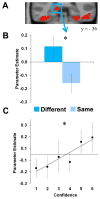Detecting changes in scenes: the hippocampus is critical for strength-based perception
- PMID: 23791201
- PMCID: PMC3694276
- DOI: 10.1016/j.neuron.2013.04.018
Detecting changes in scenes: the hippocampus is critical for strength-based perception
Abstract
Recent findings have ignited a controversy over whether the hippocampus is critical for visual perception as well as memory. Some studies have shown that hippocampal damage impairs perception of scenes, but others found no evidence for hippocampal involvement. These studies measured perception as a unitary phenomenon, but recent findings indicate that perceptual discriminations can be based on two kinds of information: states of perceiving local differences or global strength of relational match. In the current study, we separated state- and strength-based perception using a change detection paradigm with scenes. Patients with selective hippocampal damage exhibited significant reductions in strength-based perception but showed spared state-based responses. In a follow-up neuroimaging study, hippocampal activation linearly tracked confidence in strength-based perception, and was not differentially associated with state-based responses. The hippocampus therefore plays a selective role in perception, contributing high-resolution strength information possibly through its role in the representation of relational information.
Copyright © 2013 Elsevier Inc. All rights reserved.
Figures



References
-
- Aguirre GK, Zarahn E, D’Esposito M. An area within human ventral cortex sensitive to “building” stimuli: Evidence and implications. Neuron. 1998;21:373–383. - PubMed
-
- Ashburner J. A fast diffeomorphic image registration algorithm. NeuroImage. 2007;38:95–113. - PubMed
-
- Baddeley AD, Warrington EK. Amnesia and the distinction between long- and short-term memory. J Verb Learn Verb Beh. 1970;9:176–189.
Publication types
MeSH terms
Grants and funding
LinkOut - more resources
Full Text Sources
Other Literature Sources

